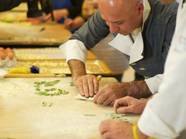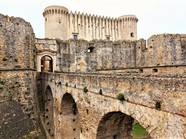Falling in Love With Leather. When Tannery is Art
There should be a reason that Italian fashion is so famous all over the world.
The tenth edition of the Arts & Tannery, the biennial exhibition of Italian leather and textile manufacturers, gave us the opportunity to discover the reason behind Italian fashion’s popularity. This event, which is organized by the Italian Leather System Consortium in partnership with the Italian Trade Commission, is an extraordinary chance for cool-hunters, fashion designers and stylists to enjoy the leather novelties of the Fall/Winter 2010/2011 season, and admire high quality materials, all researched specifically for the American market.
Speaking with the Director of the Italian Trade Commission of New York, the Consul Generalwho personally attended the event, and with the ten exhibitors showing their product at Arts & Tannery, gave me the opportunity to fully understand Italian fashion’s points of strength. Some peculiarities of Italian production, like the prevalence of small and medium clothing industries (usually characterized by family owned businesses) as well as the use of top quality and handmade products, allow this market to still thrive during the global recession.
Aniello Musella, Director of the ITC of New York explains this phenomenon:
“The small and medium enterprise is the strength of the Italian industrial system, because in periods of recession it reacts better than big corporations thanks to its flexibility and its ability to let the demand and the supply meeting. Even if we are talking of high range products, this industrial structure is able to check the costs of each moment of the production’s process, arriving on the market with a competitive final price. This is fundamental nowadays.
“Versatility is another core value of these small and medium companies. This is true especially in tannery fields, where many producers are able to create goods based on the needs of their clients, the American buyers. I have to admit that Italian fashion is showing good performance despite the difficult economic situation. In this period, in fact, big department stores, like Sacks, 5th Avenue and Bloomingdales, have restarted to purchase orders. It’s true, these orders are not equal to those of the pre-recession period, but something is in movement. Generally, I can speak of a bigger selectivity among products; the department stores are investing on the key elements of American demand because they don’t want unsold items. I can however give evidence to a return to Italian fashion productions, which are the top among the high quality products.
“The Italian Trade Commission helps direct promotion of Italian industries towards the big department stores and eventually to final consumers. For instance, we are organizing an interesting initiative for the Italian shops on Madison Avenue during Christmas Time; we want people to pay attention to Italian artisan products. In addition, we usually bring American traders directly to Italy to show them well-known fashion and design fairs. We do for Pitti, a company/exhibition in Florence, for VicenzaOro, the biggest Italian jewelry exhibition, and for the Furniture and Design fair in Milan. Very soon several American buyers will go to Milan to attend Micam, a shoe fair, and Mipel, a tannery fair, that occur at the same time.
“Obviously the main purpose is to reach the American consumer, but this always happens in partnership with US Department Stores, that are the direct contact with customers. As a result these stores, thanks to their closer relationships with consumers, convey the message of the ICT in a deeper way.”
The Consul General, Francesco Zaló, has also showed his enthusiasm towards the initiative:
“These manufacturers represent the Italian excellence, especially in a field where many European countries have given up. This happens because of Italian creativity and research. The courage that all these industries are showing by coming here for the Arts & Tannery exhibition in spite of the crisis must also be underlined. By the way, we all hope that this year will not be as difficult as the previous one.
“I have found extraordinary products in this exhibition and we have to be proud of them. What has really surprised me is that in a relatively small space there are ten different exhibitors that sell similar kinds of items without competing with one another because their products are so unique.”
Yet, to really appreciate Arts & Tannery, let’s have a look at each of the ten exhibitors, which have been so kind to also give us trend suggestions for next season:
Ausonia was founded in 1946 at Santa Croce sull’Arno;born as a familiar enterprise it is now part of a group of six tanneries located in Tuscany’s industrial area. “Our goals are quality and ecology. We care about the enviromental impact of our industrial processes and we try to
work as greenly as possible.” Also, in fashion they suggest a very natural style but with shiny colors like blue and green.
BCN Concerie was founded in 1938 at Santa Croce sull’Arno by Lupi’s Family. It is still a family run industry that tries to maintain the hand-crafted tradition. BCN’s masterpiece is the biological tannery, a process that makes leather not only ecological, but also very soft and water resistant. For the next season BCM suggests natural leather and warm colors.
Certaldese is a Tuscan company with a 60-year-old history. Unlike most of the other exhibitors, it is not a tannery, but a factory that creates semi-finished leather products, belts and bags in particular. As a result, they work with stylists and fashion designers like Michael Kors, Bottega Veneta and Armani. Certaldese is not interested in mass production and it focuses on high quality materials and flexibility.
Conceria M2 was founded 37 years ago in Santa Croce sull’Arno (PI). It is a family run, enterprise specializing in hand-crafted suede, plain or stamped. This is the 5th year that M2 participates in this fair and for this edition they have proposed a special suede treated with wax and then brushed. Regarding fashion, they advised us: “After two or three seasons of patent leather now it is time (luckily for us) for opaque leather, such as suede. Next season promises to be very casual.”
Mb3 conceria is a 15 years old enterprise, owned by Nuti’s family. This tannery, located in Santa Croce sull’Arno (PI), is the development of a former project. “In my opinion, New York is the most important fashion market in the world. That’s why I’m here for the 5th year consecutively,” Marco Nuti, Mb3’s owner has told us. His fashion advice is to go for a casual style, wearing dark colors such as black, brown and grey.
Pellegrini International is a new entry at Arts & Tannery. This familiar factory of Fucecchio (FI) works python leather and realizes many different treatments on it such as coloring, painting and embroidery. They suggest to us a very natural style, with some camouflage and dark colors.
Primorpelli is a hand-crafted tannery of Fucecchio (FI) with 20 years experience in mutton and goat leather. They mainly design winter coats, and the most common manufacturing they do consists of washing and then blowing drying the leather. In their opinion, brown will be the dominant color next year.
SanLorenzo is a family run factory from Santa Croce sull’Arno (PI) and it specializes inshearling, a pelt with leather on one side and wool on the other one. Shearling is a winter material, used mainly for coats but also for bags and boots. San Lorenzo’s tannery completely manufactures handmade goods, and offers to its customers a wide range of models and colors. This is the fifth year that they attend Arts & tannery, and they have told us that next year’s trend will be very natural.
Tuscania industria conciaria is a 15 years old tannery from Fucicchio of Florence (FI).
This factory does a very particular thing: it reproduces reptile textures on veal’s leather through very complicated handmade processes. “Our products seem to be made in authentic reptile leather, only an expert could recognize that it is veal instead. In this way, our leather is far cheaper than that of snakes or crocodiles.” For 2010 season Tuscania suggests a sporty look based on warm colors as grey, bordeaux and dump green.
Val Vibrata Ornaments is a family run company started 25 years ago in Alba Adriatica (TE). They produce metal accessories to finish bags and other leather products and they are pretty famous in Italy, as they work with Dolce & Gabbana, Roberto Cavalli and Tod’s. This is their first year in New York: “We are here because we want to explore the US market and we hope to have success,” the young director of Val Vibrata Ornaments said to us. His fashion advice for the coming season is to buy bags with big buckles colored in silver or palladium.
Since the previous year’s edition of Arts & Tannery, held in February 2008 during the peak of the economical recession, something has changed. We have perceived this change through the voices of the leather producers as well as from the comments of Aniello Musella (Director of the Italian Trade Commission of New York), who has put much effort into helping the Italian fashion industry keep its historical place in the US market even in a period of crisis. By the way, things seem to be going better now, and the American economy is starting to rise again.
The Italian market in the US has followed this positive trend thanks to its specific peculiarities. These are the secrets of Italian fashion industry: small sized and family run businesses, eco-consciousness, great creativity and a lot of passion are all characteristics that make Italian products impossible to resist!

















































i-Italy
Facebook
Google+
This work may not be reproduced, in whole or in part, without prior written permission.
Questo lavoro non può essere riprodotto, in tutto o in parte, senza permesso scritto.